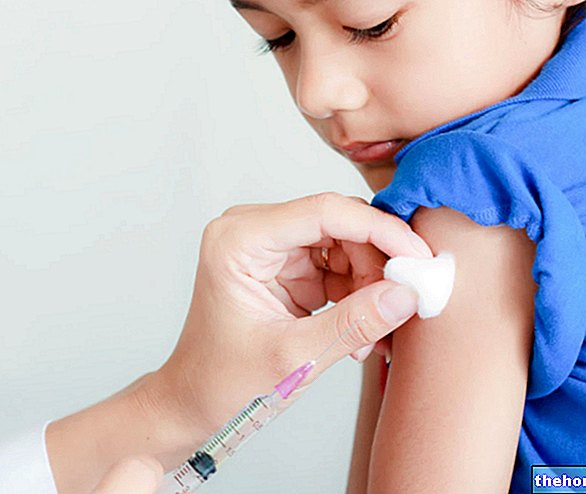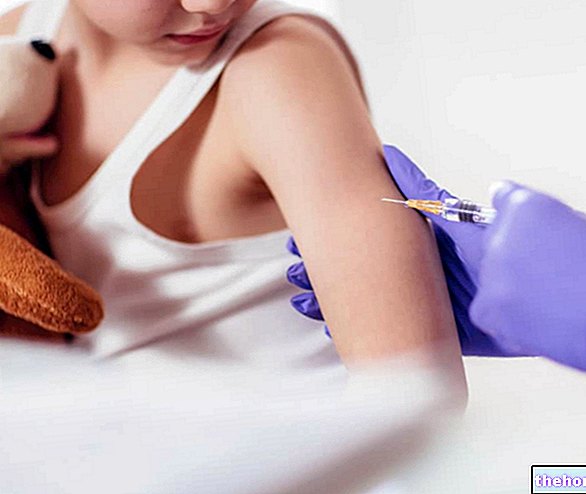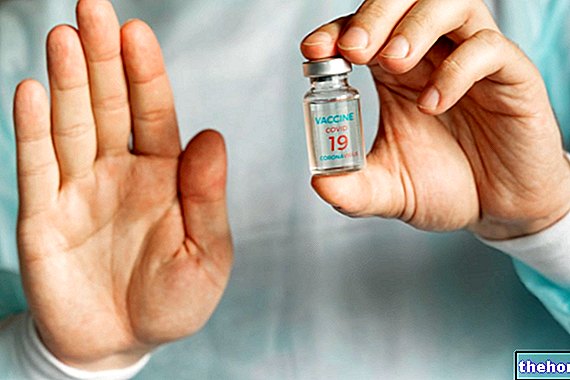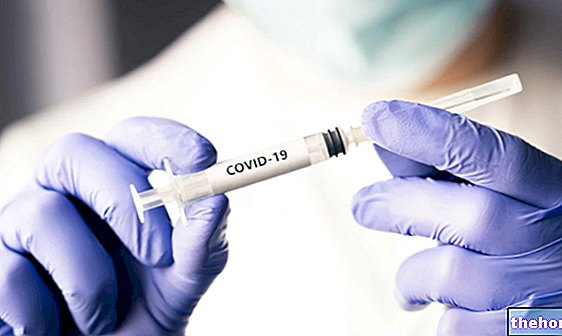Made with at least 2 dosages and through intramuscular administration, the meningococcal B vaccine is an effective and well tolerated practice; it is rare, in fact, that it fails or is responsible for side effects.

In Italy, the most commonly used meningococcal B vaccine is the pharmaceutical preparation known as Bexsero; consequently, the information in the subsequent steps of this article refers specifically to the latter.
What are meningitis and meningococcal meningitis B?
The term meningitis identifies an inflammatory process affecting the meninges; 3 in number, the meninges are the membranes that cover and protect the brain and the spinal cord, ie the two main components of the central nervous system of the human being.
The possible causes of meningitis are numerous; infectious agents such as viruses, bacteria or fungi, physical lesions affecting the central nervous system, some types of drugs, some brain tumors and certain systemic diseases can cause inflammation of the meninges.
Curiosity: when is a meningitis defined as infectious?
In the medical field, meningitis due to an infectious agent - whether the latter is a virus, a bacterium or a fungus - is called infectious meningitis.
Infectious meningitis are by far the most common and clinically interesting episodes of inflammation of the meninges.
MENINGOCOCCO MENINGITIS B
Meningococcal meningitis B is one of the most important examples of bacterial meningitis; bacterial meningitis are very feared conditions and constitute a serious danger to humans, as they can give rise to serious and sometimes fatal consequences (eg septicemia, encephalitis and / or myelitis).
Aggressive and life-threatening, meningococcal meningitis B can affect anyone, but - as statistics show - it is of particular interest to infants, young children (aged 5 years or less), adolescents, immunosuppressed individuals (i.e. people with a inefficient immune system) and, finally, individuals with diseases such as diabetes, thalassemia, severe liver disease, etc.
The symptoms of meningococcal B meningitis are quite extensive and include: high fever, vomiting, confusion, irritability, stiff neck, photophobia, headache, somnolence, paleness, seizures and epilepsy.
According to the most reliable epidemiological data, all over the world, the annual number of cases of meningococcal B meningitis would oscillate between 20,000 and 80,000 and the mortality rate would be 10%.

Fun fact: what are the subtypes of Neisseria meningitidis most important for the human being?
According to the most recent studies, there are 13 subtypes (or serotypes) of Neisseria meningitidis; of these subtypes, the most important for humans, as they can cause serious diseases such as meningitis, are: meningococcus A, the aforementioned meningococcus B, meningococcus C (see vaccine meningococcus C), meningococcus W135 and the meningococcus Y.
,For easily understandable reasons, among those at risk, those that arouse the greatest interest and represent the largest portion are infants and children.
Perhaps not everyone knows that meningococcus B is responsible for at least 80% of pediatric meningitis cases in Italy.
Method of administration
The mode of administration of the meningococcal B vaccine is only one and consists of the so-called deep intramuscular injection.
As regards the site of this injection, this varies in relation to the age of the subject undergoing vaccination; in fact, if for infants under 12 months, it consists of the antero-lateral portion of the thigh, for children aged 12 months and up , for adolescents and adults consists of the deltoid region of the shoulder.
Dosage in young and very young people
In young subjects (infants and children), the administration of the meningococcal B vaccine involves a series of dosages and boosters, so it does not consist of a single injection, but of several injections.
The precise number of dosages and boosters varies according to the age of the individual, here is how:
- If the person receiving the meningococcal B vaccine has less than 6 months, 3 dosages are foreseen within the year of life, practiced at least one month apart from each other, and a recall within 2 years;
- If the person receiving the meningococcal B vaccine has between 6 and 12 months, 2 dosages are foreseen within the year of life, practiced no less than 2 months apart from each other, and a recall during the 2nd year of life;
- If the person receiving the meningococcal B vaccine has between 1 and 2 years, there are 2 dosages, practiced no less than 2 months apart from each other, and a recall during the 2nd year of life;
- If the subject receiving the meningococcal B vaccine is a child of age sover 2 years and under 11 years, there are 2 dosages, practiced no less than 2 months apart from each other, without any recall.
Dosage in adolescents and adults
As far as adolescents (11 years or older) and adults are concerned, the administration of the meningococcal B vaccine involves 2 dosages, practiced at least one month apart from each other, without any recall.
A delay of up to the 24th month of life is allowed.
In any case, it is important that at least two months pass after the second dosage.
Meningococcal B vaccine in adults: when is it recommended?
Adults are advised to undergo the meningococcal B vaccine when:
- They have congenital or acquired "immunosuppression (reduced immune defenses);
- They suffer from a disease, such as diabetes or thalassemia, which makes them more likely to contract infections;
- They must go to a region of the world where meningococcal meningitis B is quite widespread (so there is a not negligible risk of contracting it).
Meningococcal B vaccine and mandatory in Italy
In Italy, on the basis of what the new law relating to mandatory vaccines declares, the meningococcal B vaccine is not a mandatory practice, but only recommended.
With regard to this topic, it is useful to recall in full what the aforementioned law affirms, which entered into force on 28 July 2017: "The following vaccinations are free and actively offered by the Regions:
- Meningococcal vaccination B
- The meningococcal vaccination C
- Pneumococcal vaccination
- Rotavirus vaccination
These vaccinations are offered by the Regions and the Autonomous Provinces, according to the indications of the vaccination calendar relating to the year of birth. Therefore:
- Those born in 2017 are offered free meningococcal B, anti-meningococcal C, anti-pneumococcal and anti-rotavirus vaccinations
- Those born between 2012 and 2016 are offered free anti-meningococcal C and anti-pneumococcal vaccinations "
For more information on mandatory vaccines in children, readers are encouraged to consult this article.
) of the meningococcal B vaccine contains 4 elements combined, which are:
- Three typical proteins found on the surface of all subtypes of Neisseria meningitidis. Specifically, these proteins are neisseric adhesin A (NadA), factor H binding protein (fHBP) and neisseric heparin binding antigen (NHBA).
And
- The outer membrane of the meningococcus B in vesicles. This constituent element is also known by the acronym OMV, an English acronym for Outer Membrane Vesicles (Vesicles of the External Membrane).
It is important to specify that the above 4 active elements belong to dead bacteria and have all been suitably processed in the laboratory, in such a way as not to cause an infection in any way, but only to stimulate a response from the immune system.
Auxiliary component: what are the excipients?
The excipients are substances that complete a pharmaceutical preparation, without however having any therapeutic role.
In the case of the meningococcal B vaccine, the main excipients are:
- Aluminum hydroxide;
- Sodium chloride;
- Sucrose;
- Histidine;
- Escherichia coli.
Remember that ...
The excipients present in pharmacological preparations are not negligible, as they can cause allergic reactions.
against the aforementioned bacterial infectious agent (ie meningococcus B). in the first 24 hours following the vaccine injection. Of little clinical relevance and of short duration, it represents the most common side effect of the meningococcal B vaccine;Generally, subjects with an allergy to the meningococcal B vaccine manifest this problem, with characteristic symptoms and signs, after a few tens of minutes from the time of injection.
Symptoms and signs of allergic reactions caused by the meningococcal vaccine B
Typical symptoms of an "eventual allergic reaction to the meningococcal B vaccine may consist of:
- Itchy erythema of the skin;
- Shortness of breath and severe difficulty in breathing
- Swelling of the face
- Swelling of the tongue.
A useful remedy against some adverse effects: paracetamol
In young subjects who receive the meningococcal B vaccine, the use of paracetamol is quite frequent, as the latter is able to:
- Prevent fever;
- Accelerate resolution of adverse effects such as redness and soreness at the site of infection.
Meningococcal B vaccine and pregnancy
Although further studies are needed, pregnancy does not appear to be a contraindication to performing the meningococcal B vaccine.
In any case, it is good practice for a pregnant woman wishing to undergo the meningococcal B vaccine to ask for advice, regarding her will, both from her own doctor and from the gynecologist who is treating her.




























